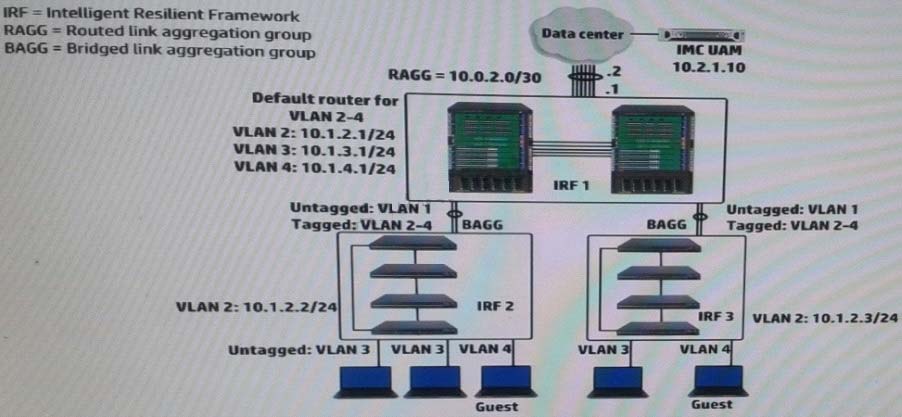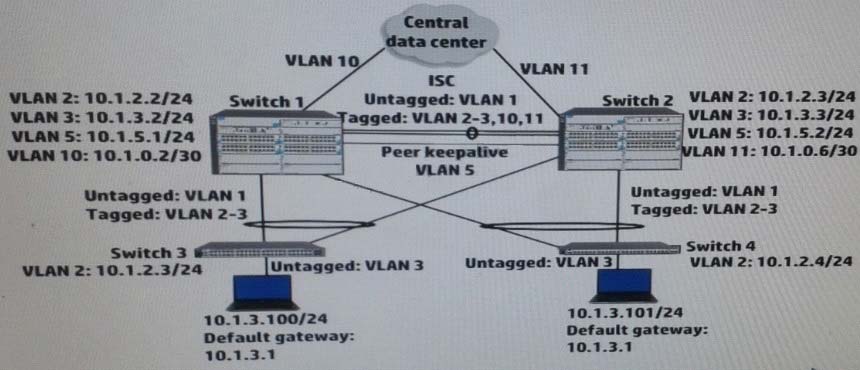HP HP0-Y47 Exam Practice Questions (P. 2)
- Full Access (55 questions)
- Six months of Premium Access
- Access to one million comments
- Seamless ChatGPT Integration
- Ability to download PDF files
- Anki Flashcard files for revision
- No Captcha & No AdSense
- Advanced Exam Configuration
Question #6
Refer to the exhibit.

A company wants to implement a portal authentication solution for guests (such a solution is also called Web-Auth). Guest belong to VLAN4, as shown in the exhibit. The intelligent Management Center (IMC) User Access Manager (UAM) will provide authentication and the Web Portal.
Where should the network administrator enable portal authentication?

A company wants to implement a portal authentication solution for guests (such a solution is also called Web-Auth). Guest belong to VLAN4, as shown in the exhibit. The intelligent Management Center (IMC) User Access Manager (UAM) will provide authentication and the Web Portal.
Where should the network administrator enable portal authentication?
- AOn the VLAN 4 interface on the core IRF virtual switch
- BOn the ports with membership for VLAN 4 on the access layer IRF virtual switches
- COn the ports with membership for VLAN 4 on the core IRF virtual switch
- DOn VLAN 4 on the core IRF virtual switch
Correct Answer:
B
Creating a VLAN Interface for the Web-Auth VLAN
The Wireless Edge Services xl Module requires an IP address on the static VLAN to which the Web-Auth WLAN maps. This VLAN must be accessible to the guests, so it should be the VLAN on the access layer IRF virtual switches.
Reference: Web Authentication for Mobile Users
ftp://ftp.hp.com/pub/networking/software/08-C05-WebAuth.pdf
B
Creating a VLAN Interface for the Web-Auth VLAN
The Wireless Edge Services xl Module requires an IP address on the static VLAN to which the Web-Auth WLAN maps. This VLAN must be accessible to the guests, so it should be the VLAN on the access layer IRF virtual switches.
Reference: Web Authentication for Mobile Users
ftp://ftp.hp.com/pub/networking/software/08-C05-WebAuth.pdf
send
light_mode
delete
Question #7
Refer to the exhibit.

Switch 1 and switch 2 run open Shortest Path First (OSPF) on all VLANs. Both switches establish an OSPF adjacency to a router at the main data center. Exhibit shows shoes some virtual Routing Redundancy Protocol (VRRP) and OSPF settings on Switch 1 during normal operation.
How can a network administrator increase the resiliency of this solution?

Switch 1 and switch 2 run open Shortest Path First (OSPF) on all VLANs. Both switches establish an OSPF adjacency to a router at the main data center. Exhibit shows shoes some virtual Routing Redundancy Protocol (VRRP) and OSPF settings on Switch 1 during normal operation.
How can a network administrator increase the resiliency of this solution?
- AImplement Bidirectional Forwarding Detection (BFD) on the peer keep alive link between the core switches.
- BChange the VLAN 10 subnet to a /24 subnet and enable VRRP on it. Place Switch 2’s link to the main data center in this subnet.
- CMake sure that, in each VRRP instance, each switch has a VRRP preempt delay of several minutes.
- DConfigure Switch 1 as an OSPF graceful restart helper in VLAN 11 and Switch 2 as a helper in VLAN 10
Correct Answer:
D
Today many Internet routers implement a separation of control and forwarding functions. Certain processors are dedicated to control and management tasks such as OSPF routing, while other processors perform the data forwarding tasks. This separation creates the possibility of maintaining a router's data forwarding capability while the router's control software is restarted/reloaded. We call such a possibility "graceful restart" or "non-stop forwarding".
Reference: RFC 3623, Graceful OSPF Restart
https://tools.ietf.org/html/rfc3623
D
Today many Internet routers implement a separation of control and forwarding functions. Certain processors are dedicated to control and management tasks such as OSPF routing, while other processors perform the data forwarding tasks. This separation creates the possibility of maintaining a router's data forwarding capability while the router's control software is restarted/reloaded. We call such a possibility "graceful restart" or "non-stop forwarding".
Reference: RFC 3623, Graceful OSPF Restart
https://tools.ietf.org/html/rfc3623
send
light_mode
delete
Question #8
A network administrator wants to configure Open Shortest Path (OSPF) MD5 authentication on VLAN 100 on an HP ProVision switch. The administrator has created a global MD5 key chain with an ID and key string that matches the neighbors. which additional step must the administrator complete to accomplish this?
- ASet OSPF authentication to MD5 mode in the OSPF area settings
- BActivate MD5 key rotation globally
- CEnable MD5 key rotation globally
- DAssign this MD5 key to OSPF VLAN 100
Correct Answer:
D
Authentication-key: OSPF supports three methods of authentication for each interfacenone, simple password, and MD5. Only one method of authentication can be active on an interface at a time.
The MD5 method of authentication requires you to configure a key ID and an MD5 Key
Reference: Chapter 8, Configuring OSPF
http://www.hp.com/rnd/support/manuals/pdf/release_06628_07110/Bk2_Ch8_OSPF.pdf
D
Authentication-key: OSPF supports three methods of authentication for each interfacenone, simple password, and MD5. Only one method of authentication can be active on an interface at a time.
The MD5 method of authentication requires you to configure a key ID and an MD5 Key
Reference: Chapter 8, Configuring OSPF
http://www.hp.com/rnd/support/manuals/pdf/release_06628_07110/Bk2_Ch8_OSPF.pdf
send
light_mode
delete
Question #9
Refer to the exhibit.

A user connects a device to GigabitEthernet 1/0/1 on switch. The device does not have an 802.1X supplicant. One minute passes. How does the switch port handle the client?

A user connects a device to GigabitEthernet 1/0/1 on switch. The device does not have an 802.1X supplicant. One minute passes. How does the switch port handle the client?
- AIt blocks the client
- BIt assigns the client to VLAN2
- CIt assigns the client to VLAN3
- DIt assigns the client to VLAN4
Correct Answer:
D
VLAN4 is configured to be a guest vlan.
Reference: ProCurve Network Security solutions, Guest VLANs: the interim solution http://www.hp.com/rnd/pdf_html/guest_vlan_paper.htm#interim_solution
D
VLAN4 is configured to be a guest vlan.
Reference: ProCurve Network Security solutions, Guest VLANs: the interim solution http://www.hp.com/rnd/pdf_html/guest_vlan_paper.htm#interim_solution
send
light_mode
delete
Question #10
A company uses 802.1X authentication to force users to connect to the network. The company uses access layer switches to enforce the 802.1X authentication and HP IMC User Access manager (UAM) as the RADIUS server.
The customer requires switches to apply a specific settings to contractor use connections. The network administrator checks the switch documentation and determines that this settings uses a vendor-specific attribute (VSA). The administrator check UAN and verifies that it has this VSA defined on it.
How does administrator configure UAM to apply the correct setting?
The customer requires switches to apply a specific settings to contractor use connections. The network administrator checks the switch documentation and determines that this settings uses a vendor-specific attribute (VSA). The administrator check UAN and verifies that it has this VSA defined on it.
How does administrator configure UAM to apply the correct setting?
- ADefine IP port groups on the access devices that need to receive the settings. Configure the VSA and its settings within these groups
- BAdd the settings to the VSA definition and then activate the VSA globally
- CCreate a scenario with the VSA and its settings: apply this scenario to the access devices that need to receive the settings
- DCreate a proprietary attribute policy with the VSA and its settings; apply this policy in the service policy for the contractor users
Correct Answer:
C
HP IMC User Access Management customizable portal pages for smart devices based on access scenarios provide a unique and personalized client experience.
Reference: HP IMC User Access Manager Software Module with 50-user E-LTU http://www8.hp.com/us/en/products/network-management/product-detail.html?oid=5443912
C
HP IMC User Access Management customizable portal pages for smart devices based on access scenarios provide a unique and personalized client experience.
Reference: HP IMC User Access Manager Software Module with 50-user E-LTU http://www8.hp.com/us/en/products/network-management/product-detail.html?oid=5443912
send
light_mode
delete
All Pages
